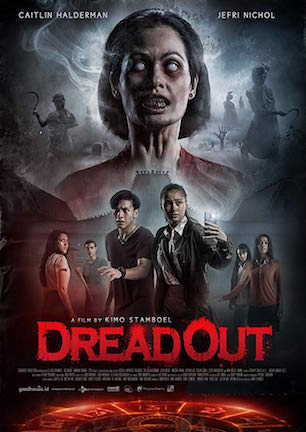Studio: Goodhouse
Director: Kimo Stamboel
Writer: Kimo Stamboel
Producer: Edwin Nazir, Wida Handoyo, Kimo Stamboel
Stars: Caitlin Halderman, Jefri Nichol, Marsha Aruan, Irsyadillah, Susan Sameh, Ciccio Manassero, Mike Lucock, Rima Melati Adams
Review Score:
Summary:
A demonic woman haunts six teenagers who open a portal while streaming their excursion inside a cursed apartment building.
Review:
Not that it’s necessarily essential for framing the film, but I didn’t realize “DreadOut” sprung out of a video game prior to selecting it for a screening. Maybe you didn’t realize it either, so some background could provide context for the movie.
You might not know about the game because it released in 2014, is only available on PC platforms and, being produced by an indie developer in Indonesia, saw its limited popularity peak primarily overseas. A 55/100 aggregate rating on Metacritic doesn’t aid awareness either. It’s therefore safe to say the game wasn’t exactly a highly talked-about hit or anything.
From what I’ve read, gadget-based survival horror mechanics liken “DreadOut” to “Fatal Frame” in more ways than one. Players take control of Linda, leader of a troupe of high school students whose wayward field trip lands them in an abandoned town. Over the course of confronting demonic ghosts and other evils, Linda learns she possesses a paranormal power linked to an otherworldly realm and a weird woman wearing red.
That’s generally the same logline for “DreadOut’s” feature film adaptation. Instead of an abandoned town however, these teens stream an excursion into a haunted apartment building hoping for social media stardom. Linda discovers she is the only classmate capable of reading an ancient parchment found in a room with an occult symbol on the floor. When she recites the incantation, Linda opens a portal that unleashes a demonic woman who wants everyone dead.
The only English-language review of the film I could find implies the movie serves as a prequel to the game, but that doesn’t appear to be true. If it is, then Linda has a really bad habit of leading high school kids into danger on repeated occasions.
“DreadOut,” which may be further distinguished from its source via the subtitle “Tower of Doom,” seems to be a straight reconfiguration of the game. Writer/director Kimo Stamboel, previously part of ‘The Mo Brothers’ with his former creative partner Timo Tjahjanto, essentially refashions the game’s fiction with boilerplate basics to produce a formulaic Friday night fright flick. Think along lines like “Ouija” (review here) and “The Gallows” (review here) and “DreadOut” basically plays like a supernatural Blumhouse teen thriller except in Indonesian.
Stereotypes feed the protagonists. Linda occupies the slot for a quintessential good girl. Being raised by a loving single father, Linda struggles to save for college by working extra shifts for a boss who takes advantage of her “can’t say no” nature. Moments meant to be endearing include a meet-cute with her crush Erik that ends with Linda being overly apologetic after accidentally spilling soda on him. Others in their friend circle include an Instagram-obsessed rich girl and a bored guy who wants to do something daring, which I’m certain is exactly how they were reductively described in a pitch meeting to producers too.
Only one of the teens has a personality that comes into play in any relevant manner. Scares in the film’s first twenty minutes occur too early to be anything other than fake-outs. Of course, the culprit responsible for these pops is the group’s resident bully, who plays one prank by impersonating a ghost before everyone flinches at clothes draped over a lamp. The bully even pulls the predictable gag of extending his hand down a dark hole and pretending to be attacked. Slick cinematography and staging help “DreadOut’s” frights look good visually, but they can hardly be described as conceptually fresh.
Once everyone melts into a mix where individuality hardly matters, “DreadOut” turns into a straightforward cycle of haunted house spooks that can be eerily entertaining as long as you disable cognitive thinking. Stamboel isn’t terribly interested in developing “DreadOut’s” depth. He’s more focused on creating creepiness with the camera, which he at least does successfully.
Video game elements have a hard time transferring to the screen. In a game, you take for granted that weird items work as weapons because you understand the medium must provide a means of offense to the player. No one wonders why Mario can throw fireballs after grabbing a flashing flower, we just accept it. In a movie though, viewers require answers for how a cellphone camera flash can hurt zombies, and “DreadOut” doesn’t have any explanations. Stamboel’s thin script also features frustratingly little background behind the demon woman’s curse, rendering much of the horror hollow since reasons rarely motivate anyone’s actions.
Even though repetitive panting and constant shouting of everyone’s names (“Jess? Jess? Jess! Jess!”) gets annoying, “DreadOut” gets by through a cool, witchy vibe that puts satanic style into its standardized creepshow. Like the game it’s based on, 55/100 reflects the film fairly because “DreadOut” is an above average thriller with some flair, although it’s more likely to be received with indifferent shoulder shrugs than to make lasting imprints in the mind’s eye. It’s approachable and efficient. Yet as alluded to earlier, if “DreadOut” were made in America, Blumhouse would have dumped it to VOD and horror fandom would have moved on with very little murmuring by now.
NOTE: There are two mid-credits scenes.
Review Score: 55






It assumes everyone watching must be a dimwit too dense to understand how the most basic storytelling concepts work.